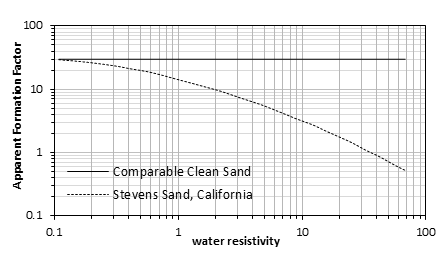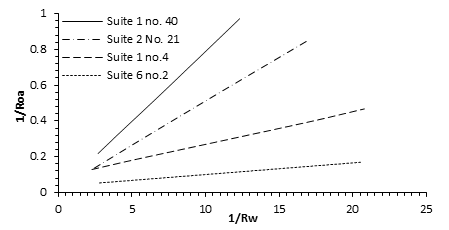Fundamentals of Fluid Flow in Porous Media
Chapter 2
Formation Resistivity Factor:
Effect of Conductive Solids
The clay minerals present in natural rock act as a conductor and are sometimes referred to as “conductive solids”, but it is actually the water in the clay and the ions in the water that are the conducting materials. Figure 2‑31 shows variation of formation factor with water resistivity for clean and clayey sands. The effect of the clay on the resistivity of the rock is dependent upon the amount, type and manner of distribution of the clay in the rock.

Figure 2-31: Apparent Formation Factor vs. Water Resistivity for Clay and Clean Sands
As shown in Figure 2‑31 the formation factor for a clay-free sand is constant. However, the formation factor for a clayey sand increases with decreasing water resistivity and approaches a constant value at a water resistivity of about 0.1 Ω·m. The apparent formation factor Fa was calculated from the definition of the formation factor and observed values of Roa and Rw (Fa = Roa/Rw). Wyllie proposed that the observed effect of clay minerals was similar to having two electrical circuits in parallel: the conducting clay minerals and the water-filled pores. Thus,

Where Roa is the resistivity of shaly sand when 100% saturated with water of resistivity Rw. Rc is the resistivity due to the clay minerals. FRw is the resistivity due to the distributed water, and F is the true formation factor of the rock (the constant value when the rock contains low-resistivity water).
Rearrange equation (2‑51)

From equation (2‑52)

Therefore, Fa approaches F as a limit as Rw becomes small. This was observed in Figure 2‑31.
The data presented in Figure 2‑32 shows the relationship expressed in the previous equation. The plots are linear and are of the general form:

Where C is the slope of the line and b is the y-intercept. Comparing with the equation (2‑51), it may be noted that C = 1/F and b = 1/Rc. The line in which b = 0 indicates a clean sand.

Figure 2-32: Water-Saturated Rock Conductivity as a Function of Water Conductivity
Questions?
If you have any questions at all, please feel free to ask PERM! We are here to help the community.
